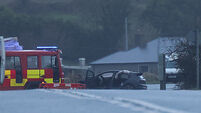Porn is never a victimless crime
This is certainly a very valid point.
However pornography is a very disturbing reality in 21st-century Ireland and the myths surrounding it as harmless fun have become more credible than the voices of its casualties.
Too often those who question how harmful it is are depicted as prudes, frigid, and Mary Whitehouse types. There is an abundance of research on the evidence of the harm caused by pornography but interestingly not much evidence to the contrary.
Pornography is no longer the dirty secret to be found under the mattress or in the bottom drawer. Because of modern technology, it is everywhere. It is available instantly, privately, and free of charge. It pops up on computers, laptops and phones, whether requested or not.
Choice does not exist in the intrusive world of pornography. According to US internet expert Donna Hughes, internet technology has now created the possibility for a person to be in one part of the world, watching and even directing live pornography, including the sexual abuse of primarily women and children, who may be on another continent. This technology provides privacy and anonymity to view and buy women and children for sexual exploitation.
Some argue that viewing pornography is a private matter, a victimless crime, if even a crime at all. If this were true, why are so many women and children trafficked and forced into sexual slavery? Why are so many women and children the victims of violent physical and sexual abuse?
Why have we in Ireland the Child Trafficking and Pornography Act 1998, which was amended by Section 6 of the Criminal Law (Sexual Offences) Amendment Act 2007 and includes among its many offences: meeting a child for the purpose of sexual exploitation which carries a maximum penalty of 14 years imprisonment and allowing a child to be used for child pornography, which carries the maximum penalty of a fine of up to €31,000 and or 14 years imprisonment?
Pornography hurts real people every day. It hurts families by creating secrets, and destroying trust. It hurts the women and children whose bodies are exploited. It hurts society by portraying women and children as objects of male gratification. It changes the power dynamic between men and women.
While the pornographers get richer, we as a society get poorer in so far as we are allowing this industry to rob us of our self-worth and dignity through its mass production of material that promotes inequality and leads to the abuse of the most vulnerable in our society.
Those who download, view, and exchange child images are an integral part of the child pornography industry. There can no longer be any argument that viewing child pornography on the internet is a victimless crime.
The children in these films are real, are exploited, and are scarred for life.
Research published by Dr Geraldine Moane of University College Dublin in 2006, demonstrated how the link between the consumption of pornography and the increase in aggressive attitudes to women, leads to a greater acceptance of the myths about rape, including the idea that women like to be raped. The Dublin Rape Crisis Centre over the past number of years has seen an increase in gang rapes and increasing physical violence accompanying the already heinous crimes of rape and sexual assault.
These are very worrying phenomena and ones that can be clearly linked to continuous exposure to pornography. Pornography desensitises and dehumanises its viewers, who can become the perpetrators of these crimes. Women are perceived as sexually available, they desire forced sex, which totally detracts from the seriousness of rape.
Dr Diana Russell, an American professor and feminist researcher, was among the first to start raising awareness about the causal relationship between pornography and sexual violence. In her book, Pornography as a Cause of Rape, she outlines research supporting the theory that pornography can cause rape.
What is most alarming about pornography is its abusive and degrading portrayal of women and children as sexual objects.
In recent times we have seen successful public awareness campaigns about the dangers of smoking, and drinking and driving. Is it time for a campaign highlighting the dangers inherent in the making of and the viewing of pornography so that we can go some way in challenging the myth that it is harmless fun and a victimless crime.
* Ellen O’Malley-Dunlop is CEO of Dublin Rape Crisis Centre
















